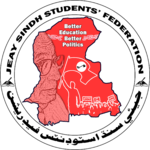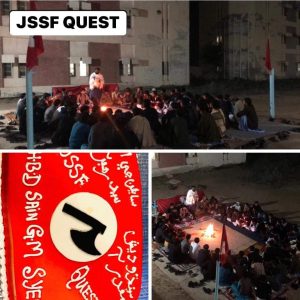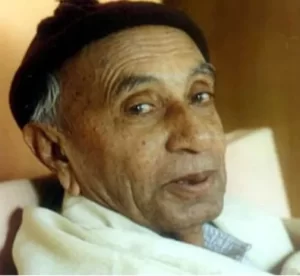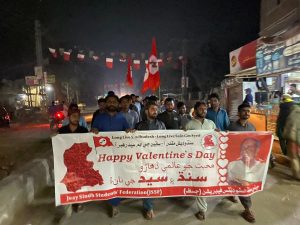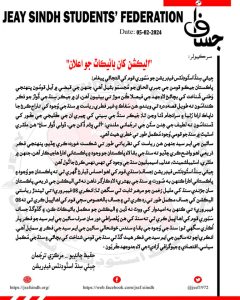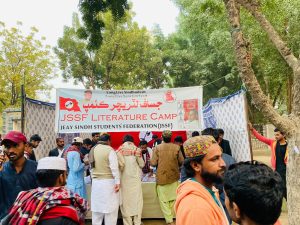G M Syed
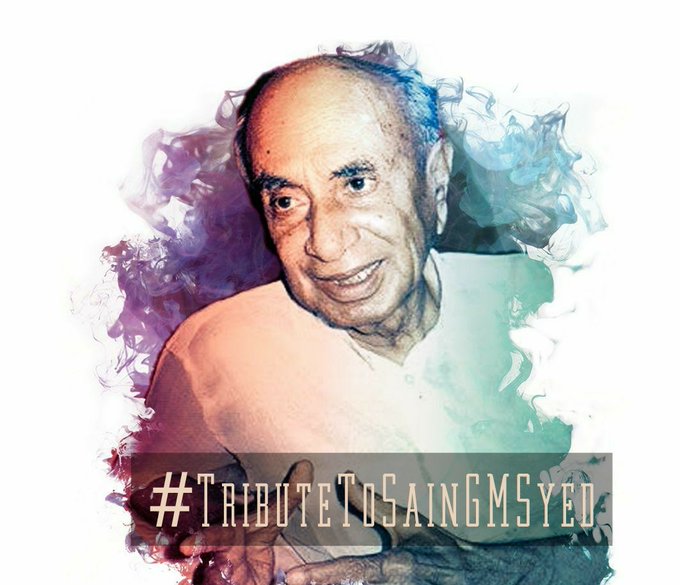
No one in the history of Sindh has affected and the influenced the culture, politics, mysticism and nationalism of Sindh than the Syed son of the Sann of Sindh, Ghulam Murtaza Shah popularly known as GM Syed. He was the real pioneer of modern nationalism in Sindh. He enjoys profound influence on the educated gentry of Sindh in one or the other way. As a political thinker, a literary pundit and a mystic he has dominated the political scenario of Pre and post-independence era of Pakistan.
He is often portrayed as the traitor among the ranks of the establishment and is one of the most misunderstood and the most aspersed founding fathers of Pakistan. He is the center round which the national ideology in the province of Sindh revolves. Being an ardent and staunch supporter of the All India Muslim League he rendered valuable contributions to Muslim League and stimulated the ideology of the All India Muslim League winning mass support in the primitive days of the struggle for Pakistan. He strove hard throughout his life for economic, moral and the social uplift of the depressed, dejected and downtrodden masses of Sindh. The editorial in the most reputed English daily of Pakistan claims Syed was the longest serving political prisoner in the recent history beating Mandella by six months.
He was born on January 17, 1904 At Sann Dadu District of Sindh. He belonged to the Syed clan of Sindh. Being the only male member of the family he had myriads of the responsibilities to shoulder.
He received early education from his home town and at very young age he started taking part in the development of his people and the society. He knew the paramount importance of education and literacy so he made up his mind to contribute in the field of education. He started his school on the British lines in his village following in the footsteps of Sir Syed Ahmed Khan under the name of Anglo Vernacular AV School. In the school Sindhi and English education were imparted to the students and education of Arabic and other languages too was imparted. In the year of 1919 he became chairman of the school board. He served as the Chairman Karachi District Local Board in the year of 1929. In the year of 1930 he became Secretary Sindh Hari Committee, the political platform striving for the rights of the farmers. In the year of 1937 he became the member of Sindh Legislative Assembly. In the year of 1938 he became the President of All India Muslim League Sindh chapter. In the year of 1940 he became the minister for education in Sindh. In the year of 1941 he became the Member of Central Committee of Muslim League.
In the beginning phase of his career he very minutely studied the plight of the Muslim farmers who were living the life of abject poverty in the province and they were deprived of the basic rights even. The conditions of the poor who were Muslims to the greater extent were manipulated by the land lord to the greater extent they were Hindus. Witnessing such plight of the farmers he vowed for the better life of the poor. He didn’t join Congress though in the earlier phase of his life he was quite inspired from the philosophy of Gandhi and wore Khadar, Khadi on his insistence as Congress was then a party supporting the cause of the landlord and in which Hindus were in majority too. How can the oppressors and the oppressed work together? He found All India Muslim League as the suitable platform to uplift the condition of living of the Muslims.
He worked very hard throughout the province as the member of All India Muslim League and strengthened it in the province, it was the sheer hard work and the commitment of Syed that All India Muslim League emerged as an alternate of Indian National Congress and the powerful voice of Muslims echoing in the Assembly.
He parted his ways with Quaid e Azam Muhammad Ali Jinnah on several issues of politics and specially the sovereignty of Sindh and several other political issues. He formed his own political party under the name of Progressive Muslim League. He was elected as the leader of coalition party in Sindh Assembly. He was the first political prisoner of the Pakistan.
He became the chairman of Sindhi Adbi Board in 1954. He played an extremely active role in the formation of Pakistan National Party. Following the same year he founded Bazam-e –Soofiya-e Sindh. Again in the year of 1969 he formed Sindh United Front. In the year of 1972 he formed Jeay Sindh Qaumi Mahaz. This mortal man bid adieu to this world on April 25, 1995 but his immortal contribution and praiseworthy books will remain forever.
The personality of Syed has gone under the process of evolution and the consistent transformation. He rose to the arena as the Pan Islamist then transformed into the Indian Nationalist, from Indian Nationalist to Pakistani supporter and then the Sindhi nationalist.
To the great number of people GM Syed is considered as just a politician who had role in the formation of Pakistan like many other leaders and then out of conflicting situation with the party lead he parted his ways but the fact is reverse. Besides being a politician he was the writer of reverence and repute, the philosopher, the religious scholar and the educationist. The personality of GM Syed cannot be confined to one particular politician only but on the other hand he was the writer par excellence. He contributed 60 books to the literature, philosophy politics and the religion.
His books include Janab Guzariyum jin seen,the book has been recommended in the competitive studies for the years. It was one of the recommended books of Sindhi subject for CSS. The book contains the biographical sketches of the personalities with whom the writer had spent some days of his life. This book very beautifully describes the trends and the prevailing social norms and political arena of the Sindh province. The personalities include the cream of Sindh having their contributions almost in all walks of the life. The psychological analysis of the writer reaches on its acme when he presents the characters as he perceives them. While reading the book one can easily have the idea of Sindh and its norms and prevailing political practices and above all the life style of gentry and political elite. Syed lets the reader deep into the roots and whenever reader comes out he wonders at the style, analysis and the selection of the words.
In his another book Sindh ja Soorma He has beautifully portrayed the lives and the contributions of those unsung heroes of Sindh who have rendered valuable contribution to the greater cause of Sindh and humanity at large. These heroes have often been mis portrayed and kept in dark by the people preaching certain mentality and bent of mind.
“Your Honour!
For three quarters of century now, I have struggled for the emancipation of my oppressed people who live in these parts of South Asia. All this while, I have earned the ire of rulers who have usurped power. On numerous occasions I have been under house arrest or in jails during the best years of my life. Whenever I have tried to raise my voice against the vandalization of Sindh, my motherland, I have been jailed. Several attempts have been made on my life.”
Thus the majestic book Sindh Case, Sindh Galhae Thee, starts with the self explanatory rhetoric. It is the remarkable book ever written. In fact it is the statement that he has given before the court of law during the hearing of one of the cases. This book in fact shows that historical perspective of Sindh and very beautifully presents the political scenario of Sind and his contribution and the transformation of his personality and causes of the transformations and effects. This book very skillfully deals with the autobiography of the writer and a concise and comprehensive book on the history of Sindh during post partition era.
His other book describes the best his ideology and the vision and the mission of his endeavors, the struggle for new Sindh, Nayeen Sindh lai Jad wa jahad.
His most famous book on the religion and philosophy is Religion and Reality. It very exquisitely deals with the issues of philosophy, mysticism, religion and above all his ideas on religion. It draws the comparison between the different religions and condemns the religious extremism in any form. It presents the evolutionary history of Sindh. The book came under the harsh and raucous criticism from the extremists and besides the title of the traitor of the state, the fatwa of infidelity came on his way but this didn’t obstruct his way to reality and kept moving on. He went on writing that the final stage in the process of the evolution of the religion is mysticism. He calls mysticism, tasawauf as the natural religion which exhorts pantheist philosophy of Wahdat ul Wujood. He considers the loyalty ity and sincerity to one’s family, nation and the homeland as genuine stages towards a superior love for God. According to him tasawauf initiates the genuine feelings of solidarity with the entire humanity and it does account for more exclusive forms of solidarity based on the natural boundaries of kinship, language and territory.
His most incredible contribution to the Sindhi literature is his book on the life and philosophy of the great poet that Sindhi literature has ever produced, Shah Abdul Lateef Bhittai. The name of the book is Pegham e Lateef, the message of Shah Lateef. He has given the comparative analysis of the message and poetry and philosophy of Lateef and in fact it is his commentary on the works of Lateef that helps a lot in the clear understanding of Lateef. He along with the other writers stimulated the literary struggle and presented the true picture of Lateef which was left untouched then. He brought into light the progressive element which was untouched as said earlier and Lateef was restricted to the tombs and shrines.
Syed modeled his movement on the way of nonviolence. He was against violence be it in any form. He was among very few of those in the days of the religious frenzy and fanaticism who strongly advocated the separation of the faith from the affairs of state. His stance over the mingling one’s faith with the state was very clear and unequivocal.
He exhorted and preached the mystic ideas and the political progression coated in form of an organization called Bazm e Sufiya e Sindh. It was the cultural Renaissance not only in its concrete forms but the prime focus was laid on the abstract forms. It was more a cultural Sindhi nationalist movement and was aimed at reviving the cultural norms of Sindh. It also boasted some other famous Sindhi scholars, who set out to create an elaborate historical, intellectual and the political narrative of Sindhi culture and history, presenting it as distinct, yet based on pluralistic values.
He blended Sindhi nationalism with the communism. His immortal contribution in exhorting Sindhi Nationalism can in no way be spared. In the history he is remembered as the one of the founding fathers of Pakistan. He stood by Muhammad Ali Jinnah in the struggle of Pakistan. He parted ways with Jinnah when the time for the reaping of the crop came. In his personality and struggle he was a complete paradox. He was the staunch believer of Islamic ideology and was more inclined towards the Islamic teachings whereas after some years he became the ardent supporter of secularism and preached secular ideology.
He ardently believed in the emancipation of all the oppressed people from the subjugation of feudals and the agencies of exploitation.
He was the staunch proponent of human dignity and the freedom.
